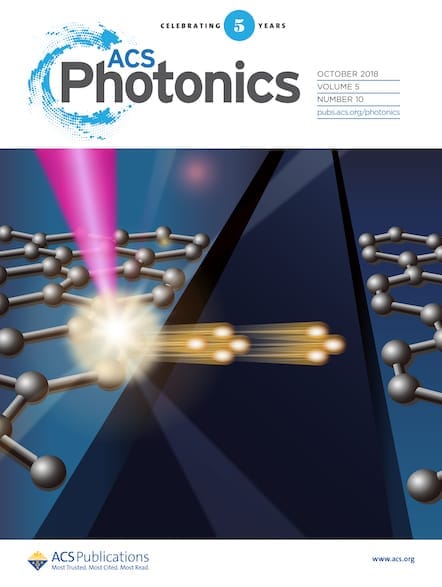Read an exclusive interview with the winner, Letian Dou, and learn more about his work and career.

ACS Photonics and SPIE, the international society for optics and photonics, are proud to announce Letian Dou of Purdue University as the recipient of the 2025 ACS Photonics Young Investigator Award. This award honors the contributions of an early-career individual who is doing outstanding work in the research areas covered by ACS Photonics.
Dr. Letian Dou is currently the Charles Davidson Associate Professor of Chemical Engineering and Chemistry (by courtesy) at Purdue University. He obtained his B.S. in Chemistry from Peking University in 2009 and Ph.D. in Materials Science and Engineering from UCLA in 2014. From 2014 to 2017, he was a postdoctoral fellow at University of California-Berkeley and Lawrence Berkeley National Laboratory. His research interest includes the design and synthesis of organic-inorganic hybrid materials and low-dimensional materials, fundamental understanding of the structure-property relationships, as well as applications in high performance optoelectronic and photonic devices.

He is a recipient of AIChE Nano Science and Engineering Forum (NSEF) Young Investigator Award (2024), Humboldt Research Fellowship (2024), Purdue College of Engineering Faculty Excellence Award for Early Career Research (2023), Waterloo Institute for Nanotechnology (WIN) Rising Star Award (2022), AIChE Owens Corning Early Career Award (2022), NSF CAREER Award (2021), Advanced Materials Rising Stars Award (2021), Office of Naval Research Young Investigator Award (2019), Highly Cited Researcher in Cross-Fields (2019-present), MIT Technology Review Innovators Under 35-China Award (2018), and MRS Graduate Student Award (2014).
Read the Interview with Letian Dou
What does this award mean to you?
Receiving the ACS Photonics Young Investigator Award is a tremendous honor and a meaningful recognition of my research in the fields of materials chemistry and photonics. This award validates the hard work and dedication that my team and I have put into advancing our understanding and application of novel materials for photonics. It also serves as an inspiration to continue pushing the boundaries in this exciting field. Furthermore, it motivates me to mentor the next generation of scientists and researchers, fostering a collaborative environment that can lead to groundbreaking discoveries. This accolade not only acknowledges past achievements but also energizes my commitment to future research endeavors that can have a lasting impact.
How would you describe your research to someone outside your field?
We are an interdisciplinary group combining knowledges in chemistry, physics, and engineering principles to design and study next-generation low-cost and high-performance semiconductor materials for optoelectronics and photonics applications (to make better solar cells, LEDs, and lasers). On one hand, our group design and synthesize organic-inorganic hybrid materials to combine the bests of the two worlds. For example, we defined the concept of “Organic Semiconductor-incorporated Perovskite”, or “OSiP”, which exhibit fascinating hybrid quantum well structures and can be obtained via simple solution-phase self-assembly processes. We grow single crystals, heterostructures, and thin films to understand their basic optical, electronics, photonic as well as chemical and mechanical properties. On the other hand, our group fabricate and demonstrate proof-of-concept devices using the novel material we developed to establish structure-property-performance relationships. Eventually, we hope to translate the fundamental knowledge into something useful in our daily life (we also collaborate with industries).
What do you think is the biggest challenge currently in your area of research?
Some of the materials and devices have excellent electronic properties and performances. For example, hybrid perovskite materials are nearly perfect candidate for solar cells and NIR lasers, but unfortunately they are not stable (at least people haven’t found the best to way stabilize them long enough for commercial use). To identify new materials with better properties and stabilities, it is very challenging and sometime very empirical. AI and ML are playing more and more important roles in materials discovery, and I hope to learn more and engage more.
What is next in your research?
We hope to continue to develop better materials, particularly addressing stability issues. We are eager to explore larger scale fabrication and integration, such as demonstrating photonic circuits and on-chip integration, using the novel materials we developed. Finally, we are also interested in trying to generate single photon and chiral photons in a better way through unprecedented materials design principles.
What would your advice be to someone just starting out in the field?
I always tell our first-year graduate students that what matters most isn't what you've done in the past, but rather your passion for future directions and your desire to learn new things and experiment. If you don’t enjoy what you’re doing, discover what you truly love and pursue it. Don’t be afraid to change, step out of your comfort zone, and think outside the box.

